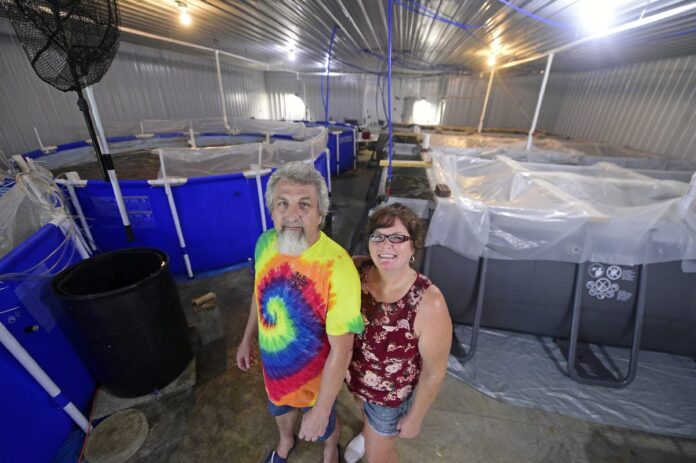
NEW PALESTINE — Glen and Kelli Schmeisser’s new farm doesn’t raise the kind of livestock that’s usually found in central Indiana.
In their barn, there are no pens or feed troughs, but rather pools containing thousands of shrimp.
The couple recently started K&G Shrimp in Shelby County about a mile south of its border with Hancock County. Engaged in the practice of aquafarming, or aquaculture, they raise the animals by keeping careful watch over their aquatic conditions. For Glen, the venture is something of a second act that allows him to continue using his science background.
[sc:text-divider text-divider-title=”Story continues below gallery” ]
The Schmeissers describe their endeavor as an adventure of experimentation and learning things the hard way at times. They’ve conducted research, talked with other shrimp farmers and visited shrimp farms in the region.
They ordered their first shipment of 26,000 shrimp about five months ago form a supplier in Texas.
“They’re teeny tiny little, about the size of your eyelash,” Kelli said.
The shrimp were supposed to be shipped overnight, but the plane got delayed by weather, causing about 90% of them to die before they arrived. The Schmeissers had to wait almost a month for a new shipment to be ready.
When shrimp arrive at K&G, they start out in two smaller nursery tanks in the barn in the Schmeissers’ backyard. As the shrimp grow, they’re transferred to one of the six 3,500-gallon pools that fill the barn.
From the time shrimp arrive, it takes about four months for them to grow big enough to sell.
Inside the warm and humid barn, blowers hum as they pump air through tubes into the bubbling pools, supplying the shrimp with oxygen. Nets drape over the pools to keep the animals from jumping out.
The shrimp grow the best in water that’s between 84 and 86 degrees, Glen said.
“It’s tropical in there,” Kelli added.
Beyond the pools is the barn’s laboratory, complete with pH meters, a scale, oxygen meter, microscope and list of water parameters to be monitored. On the metal wall above the desk, calculations are scribbled in dry-erase marker. Not far is a generator in case the barn loses power.
The shrimp’s food comes in pellet form. Based on calculated measurements, the Schmeissers feed them several times a day.
Throughout their research, they’ve learned that advice on shrimp farming varies widely.
“Everybody knows what to do, but when you ask everybody what to do, everyone contradicts each other,” Glen said. “Everybody’s different. In the process of doing all this, I’ve discovered — the hard way — how to get it done. And just because it works for somebody, doesn’t mean it’s going to work for me, and that’s because of the water.”
Glen, who has a master’s degree in molecular biology, worked in biochemistry as a scientist at an Indiana University research institute in Indianapolis for 23 years until funding for his position was cut.
As the couple thought about what to do next, they knew an ideal option would be something that allowed Glen to use his science background, Kelli to use her experience in nonprofits and sales, and something that would allow both of their social personalities to shine.
On Christmas Eve they visited Kelli’s father, who served shrimp for dinner.
“They were just the best things I’d ever tasted,” she said.
She was surprised to learn they came from a shrimp farm in Muncie, something she knew nothing about.
“So on Christmas Eve, we put YouTube on the big screen and we all sat there and watched shrimp farming videos for a couple hours,” she said with a laugh.
What began as a curiosity has become their career.
Aside from building the shell of the barn, the Schmeissers, who don’t use any pesticides, antibiotics, steroids or insecticides, designed and developed much of their operation themselves.
“The miracle about this is that the fish are almost inconsequential,” Glen said. “What we do is take care of the water… My job is to make sure that the water chemistry is right. As long as the water chemistry’s right, the animals take care of themselves. So I have to study that and watch it, make adjustments so that the animals can thrive.”



